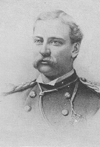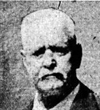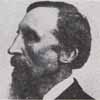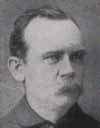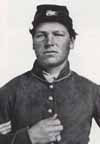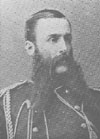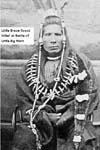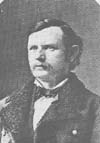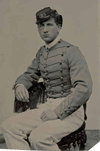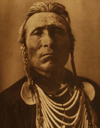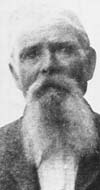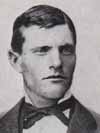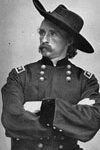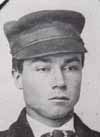Martin Personeus died in Carlinsville, Illinois, on December 24, 1889. He was a Private in Company L who was on detached service during the Battle of the Little Bighorn.
 Giovanni Martini (left) died on December 24, 1922, in Brooklyn, New York, and was buried in Cypress Hills National Cemetery there. He was the Trumpeter for Company H who brought the famous “be quick” note to Benteen.
Giovanni Martini (left) died on December 24, 1922, in Brooklyn, New York, and was buried in Cypress Hills National Cemetery there. He was the Trumpeter for Company H who brought the famous “be quick” note to Benteen.
John James Carey died in Malone, Grays Harbor County, Washington, on December 24, 1929, and was buried in Pioneer Cemetery in Centralia, Lewis County, Washington. He was a Private in Company B who was with the pack train and in the hilltop fight.
Merry Christmas!
Thomas W. Coleman was born on December 25, 1849, in Troy, New York. He was a Private in Company B who was with the pack train and in the hilltop fight.
Edwin B. Wight was born in Casco, Maine, on December 25, 1851. He was a Private in Company B who was on detached service during the battle.
William Millard Caldwell married Blanche Miller on December 25, 1887, in Clearfield, Pennsylvania. He was a Private in Company B who was on detached service during the battle.
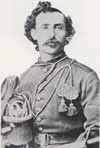 Thomas Wilford Harrison (right) died on December 25, 1917, in Philadelphia, Pennsylvania, and was buried in the Holy Cross Cemetery in Yeadon, Pennsylvania. He was a Sergeant for Company D who was in the hilltop fight.
Thomas Wilford Harrison (right) died on December 25, 1917, in Philadelphia, Pennsylvania, and was buried in the Holy Cross Cemetery in Yeadon, Pennsylvania. He was a Sergeant for Company D who was in the hilltop fight.
Max Hoehn was born in Berlin, Germany, on December 26, 1854. He was a Private in Company L who stayed with the regimental papers at Powder River so he was not in the battle.
 Stephen Cowley (left) was born on December 26, 1846, in Sligo, Ireland. He was a Private in Company D who was not present at the battle due to detached service at Yellowstone Depot.
Stephen Cowley (left) was born on December 26, 1846, in Sligo, Ireland. He was a Private in Company D who was not present at the battle due to detached service at Yellowstone Depot.
Timothy Haley was born on December 26, 1846, in Cork, Ireland. He was a Private in Company H who participated in the hilltop fight. He died on December 31, 1913, in Washington, D.C., and was buried at the Soldiers’ Home National Cemetery there.
John Meyers died on December 26, 1877, at Fort Abraham Lincoln in the Dakota Territory and was buried in the Custer National Cemetery in Montana. He was the Saddler for Company C, and he participated in the hilltop fight.
John J. Fay and John Fox both died in Washington, D.C., on December 26, 1932, and both were buried in the Soldiers’ Home National Cemetery there. Both were Privates in Company D. Fay participated in the valley and hilltop fights, and Fox was in the hilltop fight.
Wilson McConnell died on December 27, 1906, in King, Wisconsin, and was buried in the Wisconsin Veterans Memorial Cemetery there. He was a Private in Company K who participated in the hilltop fight.
Peter Thompson was born in Markinch, County Fife, Scotland, on December 28, 1843. He died in Hot Springs, South Dakota, on December 3, 1928, and was buried in the Masonic Section of the West Cemetery in Lead, South Dakota. He was Private in Company C who was wounded in the hilltop fight. He was awarded the Medal of Honor for his actions during the battle.
David McWilliams committed suicide at Fort Meade, South Dakota, on December 28, 1881, and was buried in the National Cemetery there. He was a Private in Company H who was not in the battle because he had been shot in the leg on the Far West on June 6, 1876.
Three were killed at the Battle of Wounded Knee in South Dakota, on December 29, 1890, and were buried at the Fort Riley Post Cemetery in Kansas.:
- Richard Winick Corwine who was a Private in Company A on detached service during the Battle of the Little Bighorn.
- Gustave Korn who was a Private in Company I and participated in the hilltop fight.
- George Daniel Wallace who was a Second Lieutenant in command of Company G during the Battle of the Little Bighorn and fought in the valley and hilltop fights.
Frank Hunter died on December 29, 1899, in Washington, D.C. , and was buried in the Soldiers’ Home National Cemetery there. He was a Private in Company F who was with the pack train and in the hilltop fight during the Battle of the Little Bighorn.
 William Jackson (left) died at Cutbank Creek on the Blackfeet Reservation in Montana on December 30, 1899. He was a scout who participated in the valley fight.
William Jackson (left) died at Cutbank Creek on the Blackfeet Reservation in Montana on December 30, 1899. He was a scout who participated in the valley fight.
David W. Lewis died on December 30, 1914, at the Government Hospital for the Insane in Washington, D.C., and was buried in Arlington National Cemetery. He was a Private in Company B who was confined during the battle.
William Henry Miller died in San Antonio, Texas, on December 30, 1914, and was buried in the National Cemetery there. He was the Blacksmith for Company E who was with the pack train and in the hilltop fight.
